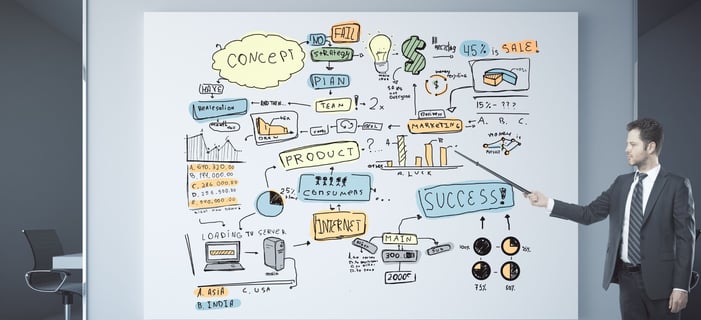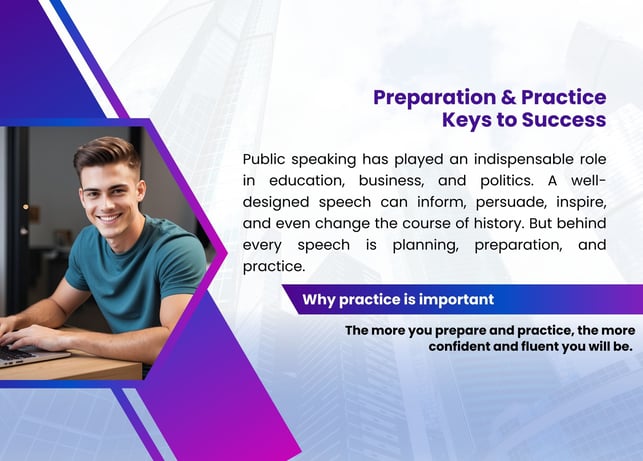The Power of Preparation and Practice
This blog post delves deep into the essential strategies for preparation and practice in public speaking, providing you with actionable tips to enhance your speaking skills and build confidence.
Mastering the Art of Public Speaking:
Preparation and Practice Techniques
Introduction:
Effective preparation and consistent practice are the bedrock of successful public speaking. Whether you're addressing a small team meeting or delivering a keynote at a large conference, the way you prepare and practice can significantly influence your performance. This blog post delves deep into the essential strategies for preparation and practice in public speaking, providing you with actionable tips to enhance your speaking skills and build confidence. By the end of this guide, you will have a solid foundation to prepare for any speaking engagement effectively and practice techniques that will make your delivery smooth and impactful.
Understanding the Basics of Public Speaking Preparation
What Does Effective Preparation Entail?
Effective preparation for public speaking goes beyond merely writing a speech. It involves a comprehensive approach that encompasses understanding your topic, knowing your audience, crafting a compelling message, and rehearsing your delivery. Preparation is the stage where you gather all the necessary ingredients before you start cooking your presentation.
The Role of Research in Speech Preparation
Research is critical in public speaking because it grounds your speech in accuracy and credibility. Start by gathering data from reliable sources—books, academic journals, reputable websites, and expert interviews. This information not only enriches your content but also boosts your confidence as you stand on a foundation of well-researched facts. Consider the following steps for effective research:
Identify key themes and topics related to your speech.
Look for recent studies and data that can add depth to your points.
Keep track of all sources to cite them appropriately and enhance the credibility of your presentation.
Tailoring Your Speech to the Audience
Understanding who you are speaking to is crucial. An effective speaker adjusts their language, tone, and content to suit the audience's interests, expectations, and level of understanding. For instance, technical jargon might be appropriate for a professional conference but not for a community town hall. Here’s how to tailor your speech:
Conduct surveys or interviews beforehand, if possible, to gauge the audience’s background and interests.
Choose examples and anecdotes that resonate with the demographic of the audience.
Adapt the complexity of your content based on the audience's familiarity with the topic.
By mastering these fundamental preparation techniques, you set the stage for a compelling and memorable public speaking performance. Each element of preparation not only enhances the quality of your presentation but also significantly reduces anxiety, as you feel ready and equipped to face your audience.
Developing a Robust Practice Routine
Crafting Your Speech Structure
A well-structured speech is the backbone of effective public speaking. It should have a clear introduction, a well-developed body, and a strong conclusion. Here’s a quick breakdown:
Introduction: Grab the audience’s attention with a hook, such as a startling fact, a question, or a compelling story. Briefly outline what you will discuss to set expectations.
Body: Organize the main points logically, supporting each with data, anecdotes, or other evidence. Make sure each point flows smoothly into the next.
Conclusion: Summarize the main points and end with a call to action or a thought-provoking idea to leave a lasting impression.
Techniques for Memorizing and Rehearsing Your Speech
Memorization can help in delivering your speech fluently, but it's important to avoid sounding robotic. Use these techniques:
Chunking: Break your speech into manageable parts and memorize each chunk separately. This makes it easier to recall the whole speech.
Mnemonics: Use acronyms or simple phrases to remember the flow of your presentation.
Practice Out Loud: Rehearse your speech as if you were presenting it. This will help you get comfortable with the content and timing.
The Importance of Timing Your Speech
Timing is crucial in public speaking. Too short may not cover all points effectively, while too long can lose the audience's interest. Practice with a timer to ensure your speech fits within the allocated timeframe. Adjust the speed of your delivery where necessary and ensure you have enough time for the essential points without rushing through them.
Effective practice is not just about repeating your speech multiple times; it’s about making each rehearsal count. Focus on different aspects each time—once for clarity, once for timing, and once for delivery. Also, consider recording yourself; video feedback can be incredibly helpful for noticing areas that need improvement, such as body language, pauses, and eye contact.
Advanced Preparation Techniques
Using Visual Aids and Support Materials
Visual aids, such as PowerPoint slides, charts, and videos, can significantly enhance your presentation by providing visual interest and reinforcing your message. However, they must be used judiciously to support rather than detract from your speech. Here are some tips for effective use of visual aids:
Keep it Simple: Slides should be clear and uncluttered. Use large fonts and minimal text.
Relevant Images: Choose images that are directly related to your content. Avoid using images solely for decorative purposes.
Consistency: Maintain a consistent style throughout your presentation materials, including colors, fonts, and layout.
Handling Questions and Interactions
Interacting with the audience can make your presentation more engaging and dynamic. Prepare for this by:
Anticipate Questions: Think about potential questions the audience might ask and prepare your answers in advance.
Practice Responses: Rehearse how you will handle questions, including those you may not have an immediate answer for.
Engage Actively: Encourage questions and show appreciation for audience input to foster a more interactive session.
Being prepared for visual aids and audience interaction are advanced techniques that can elevate your public speaking performance, making it not only more professional but also more engaging. These elements require additional preparation, but they are well worth the effort as they can significantly boost the effectiveness of your delivery.
Practical Exercises for Speech Practice
Solo Practice Sessions
Practicing alone is a fundamental aspect of honing your public speaking skills. Here are some focused exercises you can perform on your own:
Recording Your Speech: Use a camera or smartphone to record yourself giving the speech. Review the recording to assess your body language, tone, pacing, and use of pauses. Pay special attention to any verbal ticks or filler words like "um" or "like."
Mirror Practice: Stand in front of a mirror and deliver your speech, focusing on your gestures and facial expressions. This exercise helps in becoming aware of your non-verbal cues and improving your overall delivery.
Phonetic Exercises: Work on pronunciation, enunciation, and vocal projection to ensure clarity and audibility.
Group Practice Dynamics
While solo practice is essential, practicing with others can provide insights and feedback that are crucial for improvement. Consider these group practice strategies:
Peer Review Sessions: Organize sessions with fellow speakers where you can practice your speeches and provide constructive feedback to each other.
Mock Presentations: Set up a simulated presentation environment with a small audience. This could be with friends, family, or colleagues. The goal is to mimic the actual speaking conditions as closely as possible, which can help reduce anxiety and improve your comfort level in front of a live audience.
Role-playing Exercises: Engage in role-playing to handle different speaking scenarios and audience reactions. This can be particularly useful for preparing to deal with interruptions or hostile questions.
Practical exercises, both solo and group, are crucial for turning theoretical knowledge into practical skills. By regularly engaging in these activities, you can progressively build confidence and competence in your public speaking abilities.
Overcoming Common Challenges in Speech Preparation
Dealing with Nervousness and Anxiety
Nervousness and anxiety are common challenges many speakers face, regardless of their experience level. Here are some strategies to manage these feelings:
Preparation: Often, anxiety stems from a fear of the unknown. Thorough preparation and familiarity with your material can significantly reduce anxiety.
Breathing Techniques: Practice deep breathing exercises to calm your nerves before and during your presentation. Techniques like the 4-7-8 breathing method can help regulate your heart rate and relax your mind.
Positive Visualization: Imagine yourself succeeding in your presentation. Visualization is a powerful tool that can boost your confidence and reduce fear by mentally rehearsing success.
Adapting to Last-Minute Changes
Changes and surprises can disrupt even the best-prepared speeches. Here’s how to handle last-minute changes effectively:
Flexibility: Be prepared to adapt your speech on the fly. This might mean cutting certain parts if time is reduced or modifying content based on the audience's earlier reactions to other speakers.
Backup Plans: Always have a plan B for technical issues or other disruptions. For instance, if your visual aids fail, be ready to deliver your content without them.
Stay Calm and Collected: Keeping a calm demeanor in the face of unexpected changes can reassure your audience and help you maintain control of the situation.
By anticipating and preparing for these common challenges, you can ensure that they do not derail your presentation, allowing you to deliver a polished and effective speech.
Leveraging Technology in Public Speaking Practice
Digital Tools and Software for Speakers
Technology offers a variety of tools that can enhance your public speaking preparation and performance. Here are some key technologies to consider:
Presentation Software: Tools like PowerPoint, Keynote, and Google Slides are fundamental for creating engaging visual aids. Utilize features like embedded videos, transitions, and custom animations to make your presentations more dynamic.
Teleprompter Apps: Applications such as PromptSmart Pro [Android] provide a teleprompter functionality on your device, helping you maintain a natural delivery without memorizing every word.
Speech-Timing Apps: Use apps like Speech Timer to ensure your practice sessions adhere to your time limits, mimicking the constraints you’ll face during the actual presentation.
Virtual Reality (VR) Training Scenarios
Virtual reality is revolutionizing public speaking practice by providing immersive environments where you can hone your skills:
Simulated Audiences: Platforms like Ovation and VirtualSpeech offer VR environments that simulate various audience sizes and reactions, providing a safe space to practice and receive immediate feedback.
Feedback and Analytics: These VR platforms often include tools to analyze your performance, offering feedback on aspects like eye contact, pacing, and use of filler words.
Integrating these technologies into your practice routine can significantly improve your preparation process, providing innovative ways to engage with your material and refine your delivery.
Long-Term Strategies for Continuous Improvement in Public Speaking
Setting Goals and Tracking Progress
For sustained improvement in public speaking, it's crucial to set specific, measurable goals that are tailored to your personal development needs. Here’s an expanded approach on how to effectively set and track these goals:
Define Clear Objectives: Goals could range from enhancing your rhetorical techniques, such as the use of metaphors and analogies, to improving your physical presence on stage through better posture and gesture control.
Smart Milestones: Break each goal into smaller, manageable milestones, such as delivering a certain number of speeches each month or mastering a specific skill within a quarter.
Measure Progress: Implement tools like video recordings to assess your performance. Apps like Coach's Eye can be particularly helpful as they allow you to annotate and analyze videos for detailed feedback.
Journaling: Keep a speaking journal where you note down the insights and reflections from each speaking engagement, tracking improvements and setbacks.
Continuous Learning and Development
To remain effective and engaging as a speaker, continuous learning and adaptation to new speaking trends and audience expectations are vital. Here’s how you can ensure continuous development:
Attend Workshops and Seminars: Regularly update your skills with new workshops and seminars. For example, attending an annual conference on communication trends can provide fresh insights and techniques.
Join Speaking Clubs: Beyond Toastmasters, consider joining niche speaking clubs or online forums that focus on specific aspects of public speaking, like persuasive speaking or technical presentations.
Advanced Courses: Look into advanced courses that offer deeper learning opportunities, such as a Masterclass with renowned speakers like Chris Anderson of TED.
Self-Study: Leverage comprehensive resources such as:
Books: “Talk Like TED: The 9 Public-Speaking Secrets of the World's Top Minds” by Carmine Gallo offers insights into captivating an audience.
Online Courses: Platforms like Udemy and LinkedIn Learning offer courses in advanced presentation skills, storytelling, and audience engagement.
By systematically setting goals, tracking progress, and committing to continuous learning, you can maintain and enhance your public speaking skills over time, adapting to new challenges and audience expectations.






© 2024 The Confident Orator. All rights reserved.


